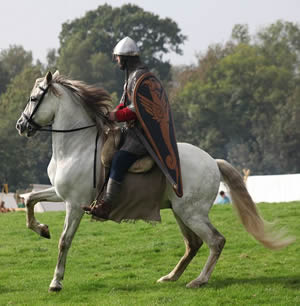General Description
In the late 1980's Andalusian breeders Linda and Allan Hamid of Woodbury, Connecticut began breeding Percheron mares to their Andalusian stallion, Embajador IX, imported from Spain. Linda Osterman Hamid first fell in love with the Andalusian horse while studying at the University of Madrid in 1965. Years later she introduced her husband to the breed. An avid horseman, historian and educator, Allan combined his interests and did research on the medieval warhorse. In 1991 the Hamids established the Spanish-Norman Horse Registry, Inc. to record the pedigrees of the unique, exclusive breed of sporthorses. The first foundation sire of the breed was Andalusian stallion, the late Embajador IX of Hamid Hill Farm, Ltd.
As of early 2004, there are 106 Andalusian and Lusitano stallions registered as foundation sires of the Spanish-Norman Horse Registry, Inc. See the official website: www.spanish-norman.com for a listing of sires located across the United States, Canada and one each in Germany and Spain.
A Spanish-Norman must be a minimum 50% Andalusian. A Spanish- Norman can be dual-registered as a Half-Andalusian with the International Andalusian and Lusitano Horse Association and compete in, that organization's shows.
The Percheron mares must be registered with the Percheron Horse Association of America or the Canadian Percheron Association or the Societe Hippique Percheronne de France. A Spanish-Norman mare can be bred to an Andalusian stallion. A Spanish-Norman can also be bred to a Spanish-Norman for a rare, second generation horse.
The Spanish-Norman Horse Registry, Inc. sponsors an annual high-point award. This trophy is awarded to the Spanish-Norman earning the most points by competing in Half-Andalusian classes at I.A.L.H.A. events, dressage, jumping, and/or any discipline at All-Breed, open shows. Spanish-Normans have the potential to excel in a variety of equine disciplines including jumping, dressage, eventing, reining and driving. An impressive exhibition and parade horse, the Spanish-Norman also performs in historic re-enactments, jousting and medieval games.
Spanish-Norman Horse Registry, Inc. President Allan Hamid states: "The main goal is to produce an outstanding sporthorse that retains the presence, physical and mental abilities of the classic European warhorse. The Spanish-Norman is destined to make an important contribution to the equestrian world."
The Spanish-Norman embodies the proud heritage of its noble ancestors: majesty, power and great presence. The breed combines the elegant beauty, boldness and natural collection of the Andalusian and the size, strength and bone density of the Percheron.
Endowed with the unique combination of presence with docility, the Spanish-Norman possesses outstanding character and temperament, qualities essential to a successful performance horse.
The majestic Spanish-Norman stands between 15.3 to 17 hands and is predominantly gray with some bays and blacks. The Spanish-Norman is a horse of substance: short coupled, strong hindquarters, sloping shoulder, ample heart girth, broad chest, medium length of neck, with its head showing a slightly convex to straight profile. Sturdy feet and legs and strong, wide hooves are the norm. Physical characteristics of this athletic breed are large, expressive eyes. The mane is thick, luxuriant and often wavy. The tail is usually abundant, long and low set. Fine, thin ears are of medium length.
The Spanish-Norman is bred to move freely from the shoulder with elastic, fluid movement and impulsion: displaying agility, engagement, cadence and elevation with extension; and projecting an image of harmony, balance and symmetry.






